With powers and energies increasing, physical thresholds face added scrutiny. Optical designs must adjust accordingly.
MARIE FREEBODY, CONTRIBUTING EDITOR
The meaning of “high power” varies considerably by sector. Indeed, the high powers that industry applications command, for example, differ vastly from those that are considered high power in the field of biomedicine.
The identifiable attributes of high power also differ by application. Where clean energy research prioritizes precision and control at extreme energy levels, military and defense place intense focus on beam quality and environmental resilience.
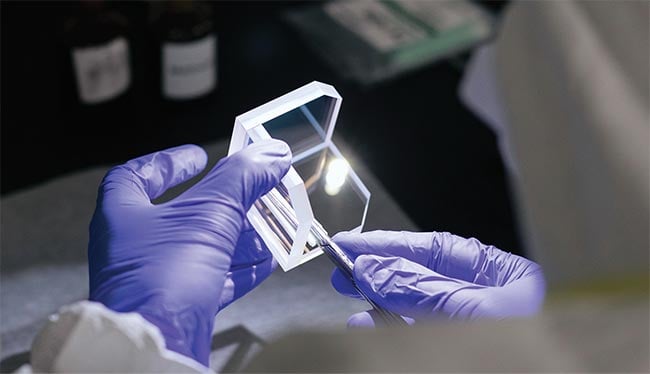
Corner cube retroreflectors retro-reflect over a wide range of incident angles, which is useful in applications where precise alignment is difficult to achieve or where vibration is present.
Courtesy of Altechna.
Industry, for its part, demands a balance between power, cost, and safety. This sector characterizes high power by driving enhanced efficiency and precision in mainstay processes such as cutting, welding, and materials processing. Industrial power levels, owing to the needs and applications of the field, fail to match the
energies used in energy research and defense.
Still, common challenges arise in the quest to achieve, deploy, and optimize the performance of high-power sources. Despite a variable meaning to the term high power, efforts to improve durability, precision, and control are enabling advancements across technology areas.
Industrial demand
Supply and market demand are co-drivers behind the evolution of the industrial laser. Industries such as semiconductor manufacturing and automotive consistently push for higher precision and
efficiency, ensuring a need for developers and manufacturers to deliver increasingly advanced lasers.
This demand also shapes the performance specifications for the laser optics. Manufacturers of these components strive to produce optics that deliver increasingly fine focus, higher power handling as necessary, and improved durability.
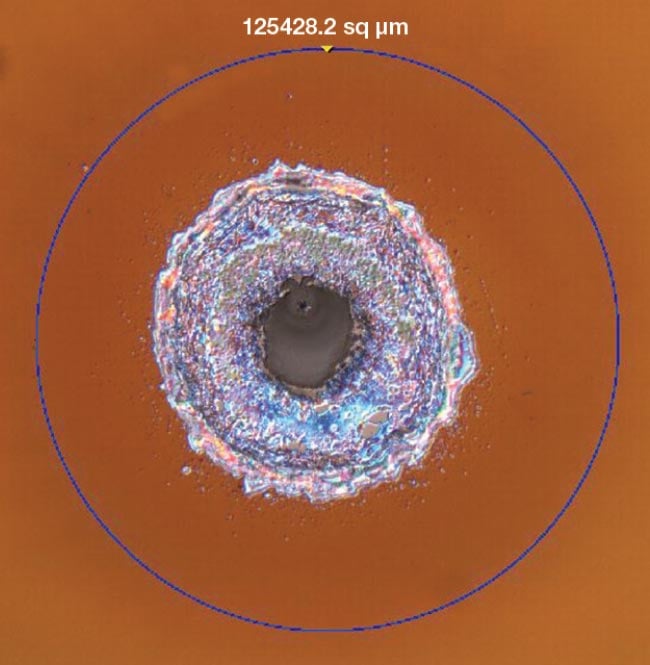
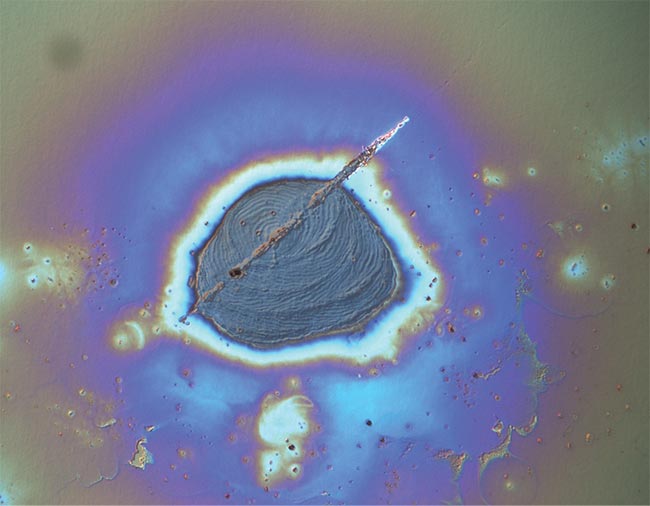
High-power laser systems are increasingly susceptible to laser-induced damage, such as the damage on a glass surface, captured here using differential interference contrast microscopy. Courtesy of Edmund Optics.
At Edmund Optics, this dynamic tends to raise questions about the practical deployment of high-power sources and
laser optics. According to Stefaan Vandendriessche, senior director of Edmund’s laser optics business group, familiar questions resurface whenever industrial laser manufacturers are poised to advance toward a new generation of high-energy systems.
Among them: “What would you do with that much power?” Also, “What would you use that much power for?”
These inquiries are less of a halt to the progression of industrial laser technology than they are a way for developers and manufacturers to maximize efficiency in the development of new products. Once a higher-power laser system is marketed for sale, it is a rapid pace at which customers from industry identify new applications that are enabled by new power levels.
Although some standard processes, for example, in the 1- to 12-kW range, have reached their limitations due to laws of physics or production demands, other
factors are behind the sustained push for new high-power laser demands and
applications.
“We have seen an increased demand from traditional plasma-cutting customers since the laser has a much smaller heat-affected zone as well as cleaner parts and more flexibility for secondary applications,” said Tracey Ryba, senior product manager for lasers in North America at the TRUMPF Inc. Laser Technology Center in Plymouth, Mich.
In most cases, 20- and 30-kW lasers with high beam quality far outperform the cutting performance and comparatively low beam quality of 40- and 50-kW lasers. But a boom in aerospace welding, electric car production, and a significant increase in heavy machinery and farm equipment is increasing demand for 10- to 20-kW lasers.
“Electric cars and power storage utilize thick copper busbars, which need high power with excellent beam quality, while thin foil stacks benefit from high-power visible wavelength lasers for effective welding,” Ryba said.
Advanced manufacturing applications also push the power — often to much higher levels. TRUMPF’s extreme ultraviolet (EUV) program, Ryba said, requires CO2 lasers of >120 kW for photolithography. Modern computer chips generally come in nanometer dimensions. Manufacturers produce the chips using UV excimer lasers. Attempts to create smaller structural sizes, <10 nm, require shifting to even shorter EUV wavelengths.
However, generating plasma radiation at the chip manufacturing-critical 13.5-nm wavelength requires a peak pulse power of several megawatts. A CO2 laser pulse of just a few watts of average power, which is boosted using amplifiers, unlocks this level.
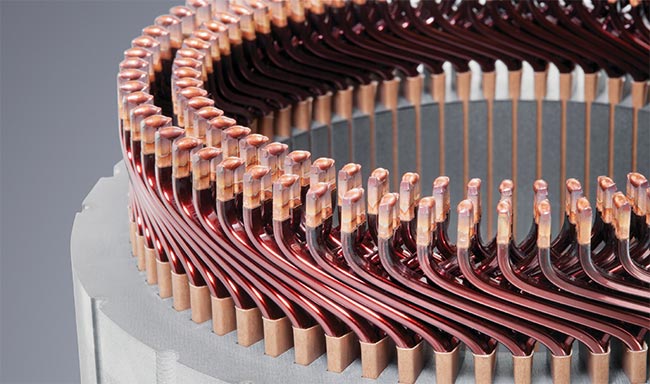
Electric cars and power storage mechanisms use thick copper busbars, which need high power with excellent beam quality, while thin foil stacks benefit from high-power visible wavelength lasers for effective welding. Courtesy of TRUMPF.
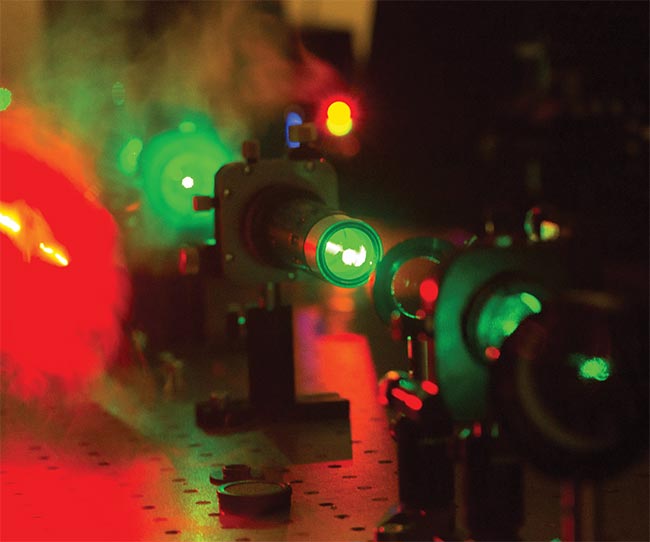
Core considerations on laser performance may vary by sector. The directed energy and defense sectors place heavy demand on high power and laser beam quality. In the industrial sector, enhanced efficiency and precision in processes such as cutting and welding are requirements. Courtesy of Altechna.
A recent collaboration between TRUMPF, lithography specialists ASML, and optical systems manufacturer ZEISS yielded the development of a CO2 laser system with a peak power >120 kW for this purpose. In this approach, five amplifiers were used to increase the power by 10,000×, resulting in tens of kilowatts of average pulse power and a peak pulse power of several megawatts. The system can process >100 substrates per hour.
Cross-sector advancements
Directed energy and defense applications are among the most demanding on high power and laser beam quality. In a fashion that is typical of the development of technology, the insights that manufacturers glean from strictly technological developments commonly inform the design of commercial products.
“There is a large overlap between the requirements for optical components
for defense and industry,” Edmund’s
Vandendriessche said. “This trickle down of technology is evident in the first appearance of high-power demonstrator laser units in defense applications,
followed by their incorporation in industrial product offerings, and extends to
the optics themselves.”
A real-world example is emerging from the European Union (EU)-funded establishment of three large laser facilities on the continent. The large laser sources at these facilities are a critical resource for members of the science R&D community
providing access to laser powers in the petawatt regime. The infrastructure is envisioned to fuel the progress that is already underway in particle acceleration, drug discovery, and fundamental science research.
Beyond the clear connection to science
R&D, the optics that the extremely high-power, high-energy systems use also showcase substantial industry know-how.
“The high output power of the laser puts enormous demands on optical components, such as the beam transport mirrors needed to guide the laser beam to the different target chambers for the respective experiments,” said Thomas Willemsen, team lead for coating design at LASEROPTIK GmbH. “Mirrors measuring 440 × 290 sq mm are required to reduce the fluency on the optics themselves,” Willemsen said.
LASEROPTIK coatings engineers and laser scientists from ELI-ERIC, one of
the three EU-funded facilities, are
collaborating to develop beam transport mirrors with improved laser-induced damage threshold (LIDT) and other
features to prevent damage of the large-size optics. The collaborators built a novel, large-size sputtering coating chamber at LASEROPTIK GmbH. “Several
design strategies were manufactured first on small-size optics and tested on dedicated LIDT measurement setups at ELI-ERIC,” Willemsen said. For the collaboration, the coating that performed best is then manufactured on the large-size substrates and tested again in the vacuum tubes at ELI-ERIC.
The frequency of cross-sector research projects that aim to manage immense energy output without damaging the individual optics comes even as the very goal of these collaborations remains a bottleneck. Efforts to address the challenge include research into advanced materials and coatings, manufacturing techniques to improve the quality of the surface finish, and advanced cooling techniques.
Today, the development of laser mirrors with improved LIDT is a wide and active field. Research groups around the world are developing novel design strategies and evaluating process parameters of deposition techniques to further improve dielectric layer stacks.
This presents its own challenge because dielectric layer stacks introduce mechanical tensions. Depending on the chosen coating technology, the coating stress may be tensile or compressive. Large-size interferometers provide a reliable tool to measure the surface flatness and effect on the wavefront of manufactured optics.
“If coating stress is too high, several strategies can be applied to equalize the coating stress,” Willemsen said. “For instance, pre-curved substrates can be used, or well-calculated stress compensation layers can be deposited on the rear side.”
Typically, Willemsen said, the surface flatness must be <λ/10, at 633 nm, over an aperture of >300 mm to achieve optimal performance for a high-energy application.
Supply insights
Additional considerations for the high-energy sources roadmap involve the presence of laser systems in emergent applications as well as supply requirements in emerging fields. On the supply side, Antanas Laurutis, CEO of optical components developer Altechna, believes that lasers are simply better than they used to be. Laurutis makes this characterization because laser systems now see use in applications that have neither typically, nor historically, required their function.
With the ability for laser manufacturers to mass manufacture high-energy systems, Laurutis said, the commercial applications that they now support are growing in number and popularity.
“Lasers are becoming smaller and easier to integrate in other systems and more laser manufacturers and standardized manufacturing processes lead to better cost structure,” he said.
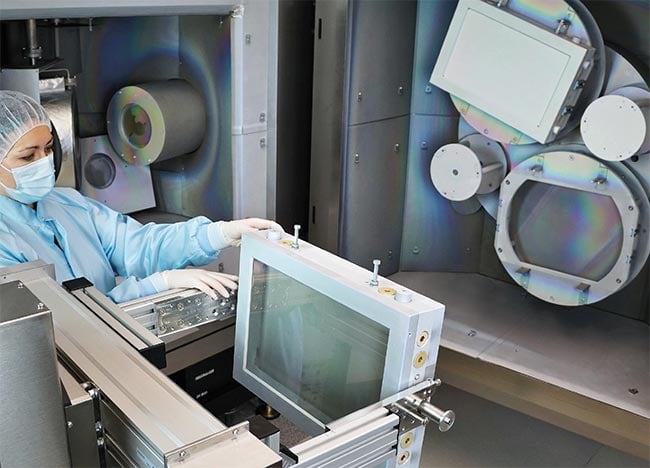
A large-size ion beam sputtering machine for the deposition of laser optics up to a diameter of 550 mm. LASEROPTIK coatings engineers and scientists from the ELI-ERIC facility are collaborating to develop beam transport mirrors with improved laser-induced damage threshold (LIDT) to prevent damage of the large-size optics. Courtesy of LASEROPTIK GmbH.
One of the fastest-growing markets benefiting from simplified integration is additive manufacturing, which offers precise speed and little waste.
Another ascending application area has yet to hit commercial maturity.
“High-energy laser systems and optics enable quantum technologies and are used for cooling atoms and ions, trapping, and generating entanglement,” Laurutis said. “The market is still emerging and there are many tasks to solve when it comes to costs, scalability, and size.”
LIDT shapes optics performance
Large optics do not correlate exclusively to high-energy applications. Nonetheless,
for many experimental and frontier research undertakings, a shift to larger optics naturally suggests that legacy (smaller) optical components are unable to accommodate the increased use of very high laser powers.
In most industrial applications, however, there is still room within the current form factor(s) to advance powers and energies with existing optical component technologies. Industrial applications tend to prioritize throughput, and so emphasize a reliable, often higher repetition rate, high energy/power performance that delivers reproducible results or specs. And these applications require operation over a comparatively long period of time.
“In the industrial, research, and defense industries, the two biggest challenges for high-power optics are optical coatings and thermal management,” TRUMPF’s Ryba said. “These two challenges can cause power loss and focal shift, but in the worst case, they can result in component failure.”
Typically, there are places in any laser system where energy/power densities are higher than in others. Although this depends on the geometry of the system, some optics can easily be changed. Others are contacted, or subassembled in one.
“For higher-power applications, transmissive components are typically avoided where possible. It’s easier to reflect higher powers and energies than it is to transmit them through material,” Vandendriessche said. “This means mirrors are the most important and are the highest quantity of components we sell.”
While the relatively few transmissive focusing elements and filters remain extremely challenging to manufacture, mirrors in high-power systems can be plano, concave, or off-axis parabolas. With the failure of one component apt to lead to the damage of multiple components, LIDT is a critical parameter to quantify. This measurement is based on statistical analysis obtained by testing a large number of samples at various energy levels to determine the threshold at which damage occurs.
Presently, however, the ambiguity of what qualifies as LIDT under current International Organization for Standardization (ISO) can leave manufacturers and end users bewildered and unprotected. Classifiers include terms such “noticeable damage.”
“The ISO 21254 standard is still the most commonly used method to specify LIDT, despite its well-acknowledged shortcomings,” Vandendriessche said. He said that efforts are ongoing to update the standard to make it more applicable to challenges posed by the high laser powers that are in use today.
For now, designers and engineers are adopting real-world application testing as an alternative to this standard when and wherever possible. In coating design and thermal management, multi-physics simulation is typically the first step in making sure high-energy optics works for different applications.
“In the end, only trials done under conditions that are as close as possible to reality can bring reliability,” said Martin Stambke, product manager of optics and sensors at TRUMPF Laser Technology in Schramberg, Germany. He said that full system characterization using time-dependent caustic and power measurements are more state-of-the-art or usually performed in a later stage of trialing.
With multiple failure damage mechanisms in their toolkit, it is critical that optical designers choose the right testing conditions. Collecting reliable data for some applications may require raster scanning of the entire coating of the optical component, which takes time and resources. Moreover, since optical components are typically designed to function effectively for thousands of hours, it is essential to consider the real-world conditions of a given application. But, only a few LIDT service providers offer accelerated lifetime testing procedures that can be supplemented with modeled predictive lifetime analysis.
According to Altechna’s Laurutis, the establishment of, and regular updates to, the ISO standard for LIDT testing is aiding a unification of required testing types. “Still, substantial revisions of the existing standards are needed to guarantee consistent and reliable comparison of LIDT
results,” he said. “In the meantime, we rely heavily on our customers’ feedback and our ability to compare the leading LIDT testing providers.”
“In instances involving exceptionally high-energy systems, we may find ourselves in a situation in which we cannot guarantee the durability of our optical coatings,” Laurutis said.
“This situation might necessitate further developments on our part, compel the client to operate the system at reduced power levels, or face the need for more frequent optic replacements, leading to
increased downtime, expenses, and
effort.”
A sense of what’s to come
Particularly for industrial applications, rigorous and frequent quality control practices are crucial to maintaining the highest standards of resistance to laser-induced damage. Optics aid in this task during the manufacturing stage and in the assessment of finished products.
Andrey Andreev, head of laser technology technical sales support at TRUMPF Laser and System Technology AG, said that he believes the next wave of developments in high-energy laser optics will pertain specifically to “smarter” optics. This includes the optimization of sensor devices.
“We have developments on the horizon related to process sensors, including artificial intelligence methods, condition monitoring, and data storage — all of which are very important to the process chain during production,” Andreev said.
With this class of sensor systems, such as those that are based on machine vison or OCT, antireflective coatings will become more complex, especially when it comes to beamsplitters and scanner mirrors, due to the angle dependencies of the coatings properties.
Further, as high-power laser systems continue to increase in performance,
efficiency, and application diversity, so too will the importance of advanced
sensors in monitoring and optimizing these systems. These sensors contribute to the improved functionality of the lasers and have profound influence on the optics that are integral to these systems.